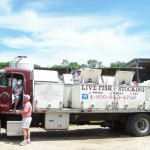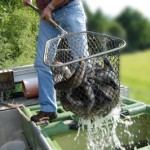There are unfortunately many examples to draw upon from our history, especially during wartime, of maternal nutritional deprivation and the long term effects on the lives of their children, and their children’s children. The list includes: diabetes; hypertension; glucose intolerance; insulin resistance; renal failure; cardiovascular disease; and hyperlipidemia.
The word “Epigenetics” has emerged as “the idea that environmental factors (to include nutrition, weather, or any outside stressors on the genetic pool), which cause the gene pool to behave differently even though the genes do not change”. These changes are permanent; last through life; and can be passed on to future generations.
What about cattle? Our paradigm has been that we have primarily been concerned about the calf and cow after birth. However, the norm has been maternal hunger during conception, where we actually plan for cows to loose weight at and following conception. This is generally due to energy/protein shortages at first forage green-up when forages are limiting in volume; or during drought; or during winter periods of shortage. Maternal malnutrition may be the norm.
More and more research is validating that not only is the last 1/3rd of pregnancy important when over 2/3rd’s of calf growth occurs in utero, but the 1st and 2nd trimester are equally important as numerous growth functions are occurring. These include: placenta development; organ development and growth, as well as muscle cell initiation, development and proliferation. These needs must be added to our historical concerns for the cow to rebreed and the calf to grow post calving.
Looking at the reproductive and economic value of the entire life stage process must include not on the post calving but the pre calving need as well. Let’s evaluate the need to have a cow in the right shape at calving and then work backwards to the importance of right or “sustained nutrition” from conception through weaning. The Research data “hands down” suggests the value of having cows in a 6 body condition score at calving. Condition score 6 cows will come back in heat quicker and breed quicker, and milk heavier resulting in increased weaning weight. Cows in a higher plane of nutrition will also sustain peak milk production longer and producer more milk per day and per 210 cycle. Cows in a 6 score at calving stand sooner allowing the calf to suck quicker receiving “first milk”, colostrum, with enhanced immunoglobulins availability for enhanced disease resistance. Bottomline, cows fed to meet their nutrient requirements versus those restricted had 12% more calves weaned per cows exposed!
Maternal nutrition in utero also programs the developing fetus. Maternal undernutrition has an effect on:
- The developing vascular system
- Reduces nutrition and oxygen to the fetus
- Fetal organogenesis
- Progeny structure, physiology, and structure
- Lung growth and function
- Response to respiratory challenge
- Skeletal cell muscle development
Effect of cow supplementation vs. no supplementation during the last trimester on heifer reproduction and calving indicate a substantial improvement not only in final pregnancy rate but the number of subsequent calves that are then born to these 1st calf heifers in the 1st 21 days and reduced levels of assistance at birth. In addition, the effect of cows on a winter program with and without supplementation in the last trimester indicates less steer calves treated if the cows were supplemented and increased hot carcass weights, in the winter range supplemented group, and improved marbling in all supplemented groups as well as increased net return per steer calf.
Land O’Lakes Purina Feed has been working on means of providing “Sustained Nutrition” for the cowherd for over 12 years, using Intake Modifying Technology. This technology allows the cow to be supplemented 24 hours a day, 7 days per week, 365 days per year. Intake of the supplement is directly correlated to forage quality, forage quantity, and cow need. Increasing supplement intake from June to January and decreasing intake as we then move into the spring and summer due to changing forage quality. Cow performance improved in both conception rate and weaning weights when the IM Technology product was provided 24/7/365.
In a second ranching location, indicate when the IM Technology product was left out on a year round basis, providing Sustained Nutrition to the cow herd versus placed out for 150 days of supplementation, that actual supplement intake was reduced, pregnancy rate increased, and weaning weights improved. The finally, pasture summary on another ranching location, over a 2 year period were the average intake per cow ranged from 1.36 lbs/hd/day in year 2 to 1.81 lbs/hd/day in year 1 during a drought. Cow body condition scores were at least 5.5 at bull turn-in averaging 86% to 91% with respective breed backs of 95.8% and 94.5%.
We sure don’t have all the answers, but supplying “Sustained Nutrition” for the cow herd while controlling intake based on forage quality sure seems to make sense. As was so appropriately said in a recent Beef Magazine Article, 2/24/2010, “They Are What Mama Eats”!
Source:
Speech given (‘Sustained Nutrition and Lifetime Performance’) by Lee Dickerson LLC Purina Mills


